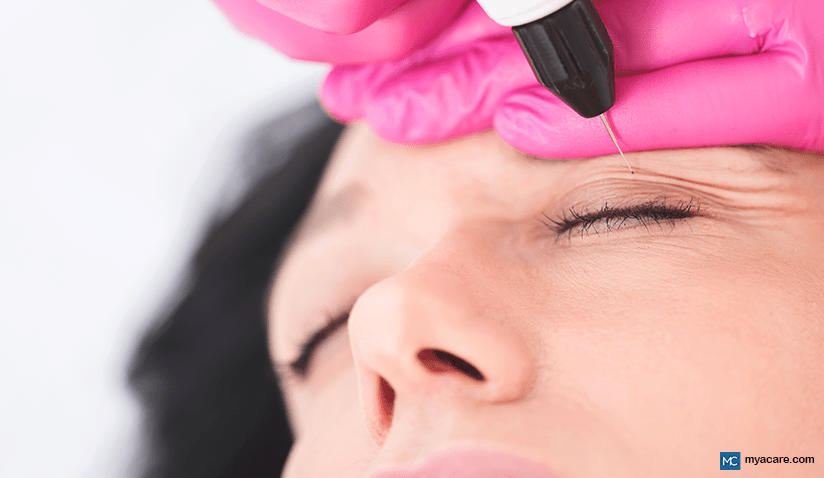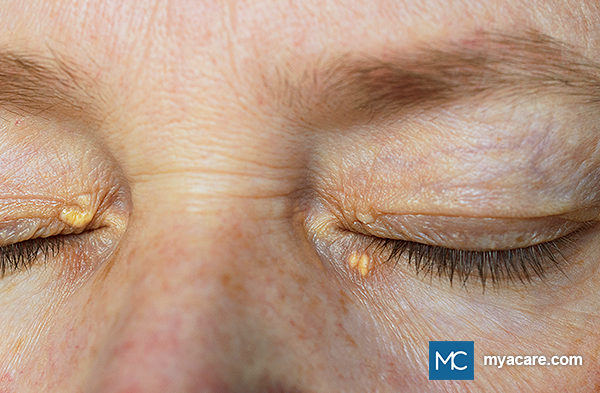YELLOW PATCHES ON YOUR EYELIDS IS IT XANTHELASMA?

Yellow patches on the skin around the eyes are not just nameless skin tags. These patches represent a very common condition that happens to millions of men and women called “Xanthelasma”.
Xanthelasma are yellow cholesterol-filled patches that form under the skin of your eyelids and near the corner of your eye. These plaques can be a manifestation of cholesterol and lipid problems or just a random occurrence. Lipids in your bloodstream are sometimes ingested by certain types of cells called “foam cells” which then deposit under your skin causing the yellow streaks.
By itself, xanthelasma is not harmful to your health, however, if you’ve just noticed having xanthelasma, it might be good to check with your doctor to assess possible underlying causes.

Who gets Xanthelasma?
Many times, xanthelasma can be a mere random occurrence without any medical significance or underlying conditions. Nevertheless, almost half of the people with xanthelasma happen to have some type of hyperlipidemia (high blood lipid levels). The factors that may increase the probability of developing xanthelasma:
- High blood cholesterol or lipids
- Gender: women seem to be more at risk than men
- Ages between 30 and 50
- Smoking
- Obesity
- High blood pressure
- Diabetes Mellitus
- Primary biliary cirrhosis (an inherited disease of the liver)
- Asian and Mediterranean ancestry
When to see a doctor?
As we’ve already said, xanthelasma by itself is harmless and is many times not caused by any serious condition. However, in many cases, xanthelasma is a sign of high blood lipids or cholesterol. Elevated lipid levels is bad for your heart and vessels and can cause your vessels to clog up (a condition known as atherosclerosis). This condition is a precursor to strokes or heart attacks. Based on this knowledge, research suggests that xanthelasma can predict a higher risk of heart disease.
That being said, if you haven’t had any formal checkup by a cardiologist or a general practitioner, you should speak about your concerns. The doctor will assess your overall health and probably order some blood work to check for possible lipid problems.
Another reason why you might want to see a doctor is when the appearance of these yellow patches is annoying you, or they’ve grown to disturb your vision, and you want them treated for aesthetic purposes.
How is xanthelasma treated?
If you’ve decided to remove the xanthelasma patches from around your eye, you have several options:
- Lowering your lipid levels might help reduce xanthelasma. Several methods discussed at the end of this article can help you control your cholesterol level. Even if this does not reduce your xanthelasma, you should consider it as an important step towards improving your cardiac and overall health.
- Surgical excision: a surgeon surgically removes the skin lesions and sutures the wound. This is suitable for small linear lesions since surgical excision can cause scarring and eyelid retraction in larger irregular plaques.
- Argon or carbon dioxide laser ablation: your doctor removes the plaques using a laser, which takes less time and requires no suturing. Some scarring or skin color changes may still occur.
- Chemical cauterization: certain chemical products can be applied to dissolve the plaques
- Electrodissection: your doctor will use a special device that sends an electric current to dissolve the xanthelasma.
- Cryotherapy: this is the use of extremely cold material (liquid nitrogen) applied directly by your doctor on the skin lesions to destroy them. It’s a good option for treating superficial plaques, however, several treatment sessions may be required.
All these treatments can be associated with some degree of scarring on your skin, and none of them can guarantee that the lesions would not recur after some time, requiring further treatment. If you wish to remove the xanthelasma, you should consult with a dermatologist or a cosmetic surgeon to discuss treatment options and risks.
How can you lower your blood lipid levels?
High blood lipid levels (hyperlipidemia) is a common medical condition that carries some risk to your overall health generally, and cardiac health specifically. High cholesterol is the most common type of lipid disorders, however, several other types exist. You should consider lowering your cholesterol and lipid levels to maintain a healthy lifestyle. Here are some methods to achieve this:
- Lipid-lowering medications: several classes of prescription drugs are available and very effective in reducing you cholesterol and lipid levels to normal levels, and hence, lowering the overall cardiac risks.
- Diet: avoiding foods that are high in saturated and trans fats, and following a more healthy diet, high in fiber and nutrients, can help you control your cholesterol levels.
- Exercise: This helps you burn off excess cholesterol and increases your HDL levels (good cholesterol), which can improve your heart’s health.
If you have xanthelasma, you now know that it’s not a harmful condition, however, it needs some investigation to make sure what’s causing it. Almost half of the people with xanthelasma have high cholesterol or lipid levels, a condition that carries a high risk to your heart’s health. By performing a few lifestyle changes you might be able to improve your health and reduce xanthelasma. Even if they fail to go away after you control your lipid levels, several effective options are offered by dermatologists and cosmetic surgeons to remove the annoying plaques.
To search for the best health providers for dermatology in Croatia, Germany, Greece, Italy, Malaysia, Singapore, Slovakia Spain, Thailand, The UAE, the UK, and the US, please use our free search engine.
To search for the best healthcare providers worldwide, please use the Mya Care search engine.
Sources:
- https://www.health.harvard.edu/womens-health/what-can-i-do-about-xanthelasma-on-my-eyelids
- https://www.bmj.com/content/343/bmj.d5497
- https://www.ncbi.nlm.nih.gov/pmc/articles/PMC3453794/
- https://pubmed.ncbi.nlm.nih.gov/9754092/
Disclaimer: Please note that Mya Care does not provide medical advice, diagnosis, or treatment. The information provided is not intended to replace the care or advice of a qualified health care professional. The views expressed are personal views of the author and do not necessarily reflect the opinion of Mya Care. Always consult your doctor for all diagnoses, treatments, and cures for any diseases or conditions, as well as before changing your health care regimen. Do not reproduce, copy, reformat, publish, distribute, upload, post, transmit, transfer in any manner or sell any of the materials in this blog without prior written permission from myacare.com.



